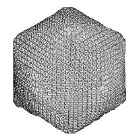Plant Pathology, Department of

James Van Etten Publications
Document Type
Article
Date of this Version
2010
Citation
JOURNAL OF VIROLOGY, Jan. 2010, Vol. 84, No. 1, pp. 532–542. doi:10.1128/JVI.01698-09
Abstract
Paramecium bursaria chlorella virus 1 (PBCV-1), a member of the family Phycodnaviridae, is a large doublestranded DNA, plaque-forming virus that infects the unicellular green alga Chlorella sp. strain NC64A. The 330-kb PBCV-1 genome is predicted to encode 365 proteins and 11 tRNAs. To monitor global transcription during PBCV-1 replication, a microarray containing 50-mer probes to the PBCV-1 365 protein-encoding genes (CDSs) was constructed. Competitive hybridization experiments were conducted by using cDNAs from poly(A)- containing RNAs obtained from cells at seven time points after virus infection. The results led to the following conclusions: (i) the PBCV-1 replication cycle is temporally programmed and regulated; (ii) 360 (99%) of the arrayed PBCV-1 CDSs were expressed at some time in the virus life cycle in the laboratory; (iii) 227 (62%) of the CDSs were expressed before virus DNA synthesis begins; (iv) these 227 CDSs were grouped into two classes: 127 transcripts disappeared prior to initiation of virus DNA synthesis (considered early), and 100 transcripts were still detected after virus DNA synthesis begins (considered early/late); (v) 133 (36%) of the CDSs were expressed after virus DNA synthesis begins (considered late); and (vi) expression of most late CDSs is inhibited by adding the DNA replication inhibitor, aphidicolin, prior to virus infection. This study provides the first comprehensive evaluation of virus gene expression during the PBCV-1 life cycle.


Comments
Copyright © 2010, American Society for Microbiology. All Rights Reserved. Used by permission.